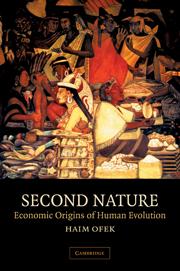Book contents
- Frontmatter
- Contents
- Acknowledgments
- 1 Introduction
- Part 1 Bioeconomics
- 2 Exchange in human and nonhuman societies
- 3 Classical economics and classical Darwinism
- 4 Evolutionary implications of division of labor
- 5 The feeding ecology
- 6 The origins of nepotistic exchange
- 7 Baboon speciation versus human specialization
- Part 2 Paleoeconomics
- References
- Index
5 - The feeding ecology
Published online by Cambridge University Press: 06 July 2010
- Frontmatter
- Contents
- Acknowledgments
- 1 Introduction
- Part 1 Bioeconomics
- 2 Exchange in human and nonhuman societies
- 3 Classical economics and classical Darwinism
- 4 Evolutionary implications of division of labor
- 5 The feeding ecology
- 6 The origins of nepotistic exchange
- 7 Baboon speciation versus human specialization
- Part 2 Paleoeconomics
- References
- Index
Summary
The incredible shrinking gut
Laboratories under sail
Among the sailors who crisscrossed the oceans during the sixteenth century few knew how to swim. It was pointless. A sailboat at sea could not be stopped or turned to rescue a shipmate washed or fallen overboard. The hazards of the occupation could not escape the attention of sailors struggling to lash unruly sails in unpredictable gale-force winds. One slip on the upper yards meant almost certain death. Given the state of the art and the perils of the sea, casualties from accidents and disease were exceedingly high even by the standards of the time. As to comforts and niceties of life – nobody could ask for, nor possibly be granted, accommodations beyond the bare minimum.
With lives aboard more expendable than cargo, one can wonder why skippers and ship stewards paid meticulous attention to supplies of food-stuff. A typical list of ship supplies for a journey across the Atlantic around 1577, the year Sir Francis Drake set out to circumnavigate the world, included such diverse items as hardtack, flour, pickled beef and pork, dried peas and codfish, butter, cheese, oatmeal, rice, honey, and vinegar, as well as about eight tons of beer. The selection seems to compare quite favorably even today with any decent hospital or school cafeteria – not counting the beer. Careful attention to an adequate bulk of food supplies before embarking on unpredictably long trips such as the one undertaken by the Mayflower (66 days across the Atlantic in 1620) is perfectly understandable. But why overburden the already hard-pressed logistics of a ship on high seas with a wide variety of food items?
- Type
- Chapter
- Information
- Second NatureEconomic Origins of Human Evolution, pp. 62 - 83Publisher: Cambridge University PressPrint publication year: 2001

